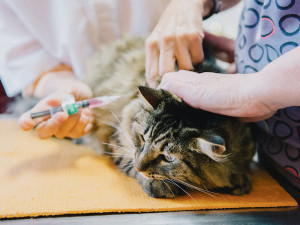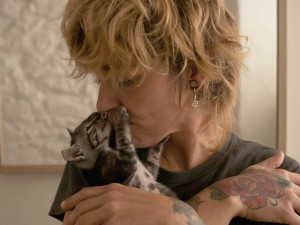7 Steps to Keep Your New Kitten Happy and Healthy
With great cuteness comes great responsibility. A vet breaks down everything you need to know when you bring home a new kitten.

Share Article
After watching countless hours of kitten hijinks on social media, you finally got a kitten of your own. Congrats! But with great cuteness comes great responsibility. Here’s a seven-step to-do list to ensure that you’re prepared to introduce a new kitten into your home.
Step 1: Stock up on basic supplies.
Kittens require multiple trips to a veterinarian for preventative care. Keep your precious cargo traveling comfortably and safely. Get a carrier that’s sturdy, roomy, and easy to clean. At home, your kitten will need new cat essentials such as food and water dishes, litter boxes, toys, and bedding.
Step 2: Kitten-proof your crib.
Cat-proofing a home involves securing any object that kittens can eat or use to injure themselves: electric cords, cords to window blinds and curtains, string, sewing supplies, rubber bands, hair ties, essential oils, cleaning products, and medications. Keep toilet lids closed. Use caution with reclining furniture — kittens love to explore their inner workings. Ensure all houseplants and flowers are non-toxic (lilies are a huge no-no for cats and a recipe for kidney injury). The list of ways your kitten can get themselves into trouble seems endless, so watch them closely to make sure they don’t find any hazards not already mentioned. Initially, your kitten shouldn’t be allowed to roam your home unsupervised. A baby gate is an easy option to keep your kitten confined to a safe area.
Step 3: Schedule vital vaccinations.
Vaccinations are essential to the prevention of serious or fatal infections. Your veterinarian will recommend a schedule for core and non-core vaccines. Core vaccines are those that are considered vital to prevent severe, often life-threatening diseases, as well as diseases that may be passed on to humans. Vaccines that protect against feline herpes virus (FHV-1), feline calicivirus (FCV), feline panleukopenia (FPV), feline leukemia (FeLV), and rabies are considered core vaccines for kittens. Additional non-core vaccines may be recommended based on your region or lifestyle (e.g. if yours is an outdoor cat).

Step 4: Protect your pal from parasites.
Kittens are vulnerable to multiple intestinal parasites. Kittens can pick up worms from eating eggs passed in feces (gross), or the worms may be passed along from their mother during nursing. Either way, fecal exams and regular deworming, typically every 2-4 weeks, are essential to your kitten’s health.
Kittens should also be protected from external parasites like fleas and ticks. Many products have a minimum age or weight requirement, so your veterinarian will inform you when your kitten is ready for preventatives. Lastly, cats are susceptible to heartworm disease and should be given heartworm prevention if they are in an endemic region. Indoor cats are not exempt.
Step 5: Spay or neuter your new feline friend.
Having your kitten spayed or neutered decreases the risk of certain diseases and cancers associated with reproductive organs. Plus, you’d be doing your part to help control the pet population (we were listening, Bob Barker).
Step 6: Socialize your little rapscallion.
Socialization is especially important in the first few months of your kitten’s life. Exposing your kitten to new people, car travel, and handling can decrease fear and stress in new situations as they get older. Strategies to socialize your kitten may include positive reinforcement for approaching people, arranging playtime with multiple new people, or enrolling in kitten kindergarten classes. Equally important is getting your kitten used to being handled and examined. Open their mouth, touch their ears, and handle their paws often. This can help immensely with veterinary visits and make everything from nail trims to medical treatment easier.
Step 7: Cuddle and bond with your new cat.
You’ve followed the steps to ensure your kitten is healthy and safe, so now comes the fun part. Cuddle, play, and of course record all the adorable kitteny hijinks — TikTok is waiting.

Dr. Alycia Washington, DVM, MS
Alycia Washington is a small-animal emergency veterinarian with over 10 years of experience based in North Carolina. She works as a relief veterinarianopens in new tab and provides services to numerous emergency and specialty hospitals. She also works as a veterinary writer with a focus on educating pet parents.
Related articles
![Woman using a laptop in bed, looking at her cat]()
What to Expect in the First 48 Hours With Your New Cat
Here’s how to help your rescue kitty feel at home.
![Great Dane dog and Chihuahua dog laying in the grass]()
Wondering How Big Your Puppy or Kitten Is Gonna Get?
We know, our pets grow up too fast. But seriously, how fast is too fast (or slow)? Kinship and Waltham Petcare Science Institute created a simple tool to help your new pet’s growth stay on track.
![Blonde woman with hand tattoo kissing her gray kitten]()
A Step-by-Step Guide to Adopting a Cat
From where to begin looking to what the adoption process entails to how to prepare your home for your new pet.
![A woman with tattoos hugging her white cat in a cluttered, art-filled room]()
Cats, Priceless. Cat Parenthood, Not So Much
A rundown of the most common cat expenses.







